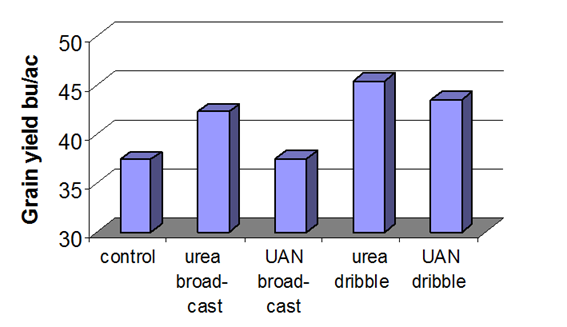Midseason Nitrogen Application on Wet Soils
With the large rainfall events across many parts of Manitoba, some farmers are noticing yellowing in their crops and wondering if they should top up their fields with some more nitrogen fertilizer. Unfortunately, there are no easy rules to follow or large experimental datasets to refer to for making this type of decision. However, there are some principles to consider.
What’s causing the yellowing? The first issue to consider is whether the crop yellowing is from N deficiency or simply flooding stress due to excess water. Applying N fertilizer onto crops that are suffering primarily from flooding stress could be a poor investment. However, the risk of losing large amounts of N due to excessive rainfall is significant. Heavy rains and saturated soils can cause large losses of nitrogen in sandy soils due to leaching or clay soils due to denitrification, especially when the weather is warm (for more information on leaching and denitrification, see extra notes at the end of this article). Medium textured soils might experience moderate losses of N due to both processes. The only way to tell for sure if the N is still there is to soil test, but that's very difficult to do in a timely manner at this time of year, especially under conditions of excess water.
How efficient is midseason application of N? If the crop is likely to recover from the excess moisture problem and yield potential is good, a midseason application of N can increase yields dramatically. Research conducted by Agriculture and Agri-Food Canada at Indian Head, SK showed excellent yield responses in most years to midseason dribble- or coulter-banded applications of 30-60 lbs of N as UAN liquid fertilizer (28-0-0) as late as the 5.5 leaf stage for wheat (stem elongation) and the mid-bolting stage for canola. However, in one of the three years, the weather turned very dry after the fertilizer was applied and this midseason-applied N did not perform very well, due to surface stranding.
Timing - Ideally, post-emergent N should be applied to cereals at or before the 3-5 leaf stage and to canola prior to bolting. There may also be an enhanced risk of stranding of N at the soil surface with prolonged dry weather. Therefore, likelihood of a benefit from post-seeding applications increases with the likelihood of receiving significant precipitation shortly after the fertilizer is applied. This is because the crop is more likely to be able to access and take up the applied N and because if yield is primarily limited by available moisture, moderate amounts of in-season rainfall increases yield potential and response to applied N.
Sources and Additives - The risk of gaseous losses from volatilization will be higher on high pH soils, which are common throughout most of Manitoba. Another factor that increases the risk of volatilization is the warm and often windy conditions that often occur at this time of year. Farmers who are concerned about volatilization losses from UAN liquid fertilizer (28-0-0) or from granular urea (46-0-0) may want to add Agrotain N-stabilizer with their fertilizer or use a source of urea that has the Agrotain “built into” the granules. Agrotain inhibits the urease enzyme and slows down the conversion of urea-N to ammonia in both of these types of fertilizer, helping to reduce the risk of gaseous losses due to volatilization.
Placement - Surface applications of fertilizer are often less efficient than in-soil banded or incorporated fertilizers, because lack of fertilizer incorporation will increase the risk of volatilization and immobilization losses. Use of a dribble-band rather than a spray or broadcast application reduces contact between the fertilizer and crop residue, reducing volatilization and immobilization losses from surface applications (Figure 1). As a result, in several field studies in Manitoba, surface dribble-banded applications of UAN were nearly as effective as in-soil banded applications.

Figure 1. Wheat yield as affected by placement of post-seeding applications of urea and UAN solution (Grant 1997).
Extra notes on nitrogen losses with excess moisture:
Leaching is the movement of N in the soil water down through the soil profile. When the N moves below the rooting depth, the plants can no longer reach the N, so it is lost for crop use and poses a threat to groundwater quality. Ammonium-N is normally bound to soil particles and so protected from leaching losses. Therefore, N in the nitrate form is much more susceptible to leaching losses is the ammonium form. Leaching will increase with increasing precipitation and is greatest on coarse-textured soils (e.g., sandy soils) with low water holding capacity.
Denitrification is the conversion of nitrate-N to gaseous forms of N, which can be lost to the atmosphere. Denitrification occurs when available oxygen in the soil is limited. This can occur under very wet or flooded conditions or when the soil is very compacted. Losses are therefore higher on fine-textured soils (e.g., clay) and in depressional areas of the landscape, such as bottom-slope positions. Even when the soil is not completely flooded, there will be microsites in the soil where oxygen availability is limited and denitrification can occur. Rate of denitrification will be faster when soil temperatures are warm (eg. in late spring or early summer) because the activity of the microorganisms that cause denitrification increases with increasing soil temperature.
Don Flaten and John Heard – June 2016

